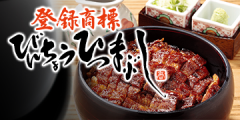- Home
- Sightseeing Spots
Sightseeing Spots
81 - 100 / 214 RESULTS
-
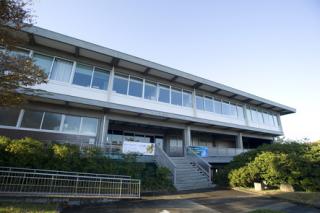
Eastern Area
Nagoya University Museum
Nagoya University Museum was established in April 2000 as the fifth integrated university museum in Japan. Its purpose is to comprehensively and internationally provide feedback, resources, and social return on the academic specimens and materials of Nagoya University, as well as the results of university research. It has six main missions: Research, Education for the Next Generation, Exhibitions, Creation and Inheritance of Knowledge, Specimen Collection, International Exchange, etc. See More
Nagoya University Museum was established in April 2000 as the fifth integrated university museum in Japan. Its purpose is to comp…See More
-
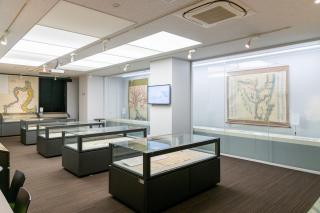
Eastern Area
Ogaki Kyoritsu Bank Takagi Family Documents Exhibition Gallery (inside Nagoya University Central Library)
The Ogaki Kyoritsu Bank Takagi Family Documents Exhibition Gallery is located in a corner of Nagoya University's Central Library, and as a permanent exhibit, it displays replicas of the Takagi Family Documents owned by Nagoya University (the establishment also holds special exhibits on other materials in the collection). The Takagi Family Documents are a collection of documents formerly owned by the Nishi Takagi family, a hatamoto clan whose fief was Tokigo and Tarago in Ishizu County, Mino Province (present-day Kami-Ishizu Town, Ogaki City, Gifu Prefecture), and some of them have been designated as Important Cultural Properties by the nation under the name "Kotai Yoriai Nishi Takagi Family-related Materials". There is no admission fee, and anyone can view them. You can also freely tour the Central Library by signing your name at the reception desk. See More
The Ogaki Kyoritsu Bank Takagi Family Documents Exhibition Gallery is located in a corner of Nagoya University's Central Library,…See More
-
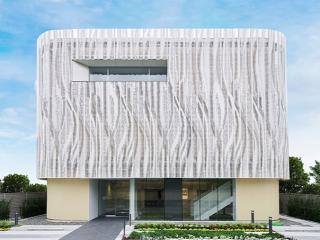
Eastern Area
Hoyu Hair Color Museum
Japan's first museum specializing in hair color, the widely known hair coloring company Hoyu opened the Hoyu Hair Color Museum as part of its 100th anniversary commemoration project. The museum highlights the culture and history of hair dyeing in Japan and Hoyu's history and involvement in the field. See More
Japan's first museum specializing in hair color, the widely known hair coloring company Hoyu opened the Hoyu Hair Color Museum as…See More
-
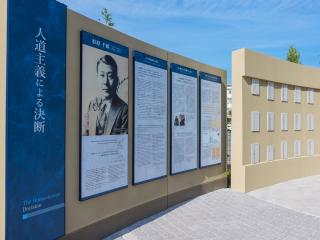
Eastern Area
The Sugihara Chiune Square - Sempo Sugihara Memorial
The Sugihara Chiune Square is an outdoor exhibition facility dedicated to honoring the humanitarian achievements of Chiune Sugihara, known for the "Visas for Life." The facility showcases life-size bronze statues of Sugihara and a Jewish family, as well as reproductions of visas on ceramic plates. Additionally, it displays historical materials from Sugihara's time at the former Aichi Prefectural Fifth Middle School (now Aichi Prefectural Mizuho High School). See More
The Sugihara Chiune Square is an outdoor exhibition facility dedicated to honoring the humanitarian achievements of Chiune Sugiha…See More
-

Eastern Area
Currently Closed
Mandolin Melodies Museum *closed
Records featuring mandolin music since 1920 and mandolins are displayed. Approximately 220 SP records, about 140 LP records, about 10 EP records, and approximately 400 CDs are displayed. Visitors wishing to listen to them can listen in the museum for a charge (SP: 300-yen, LP and CD: 100-yen). See More
Records featuring mandolin music since 1920 and mandolins are displayed. Approximately 220 SP records, about 140 LP records, abou…See More
-

Eastern Area
Shiroyama Hachiman Shrine
In the entire Joyama Forest area, there used to be a castle called Suemori Castle, which was built by Oda Nobuhide. After Nobuhide's passing, his son Nobuyuki took over, but he was defeated by his older brother Nobunaga, leading to the castle's abandonment in just about ten years. On the site of this castle, the Joyama Hachimangū Shrine was established. The shrine attracts many visitors during events such as the first shrine visit of the New Year, the summer ritual of passing through the ring of sedge, and the autumn visit of three and five-year-old children for blessings. See More
In the entire Joyama Forest area, there used to be a castle called Suemori Castle, which was built by Oda Nobuhide. After Nobuhid…See More
-
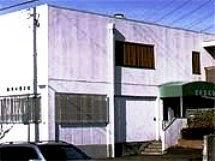
Eastern Area
Araki Shuseikan Museum
In 1952, Araki Minoru, a junior high school teacher at the time, began his journey into archaeology when one of his students discovered a single piece of pottery. Motivated by this find, he took it upon himself to establish a museum. The museum, called "Touzan Ancient Kiln Site Group," proudly exhibits excavated artifacts from archaeological sites in Chikusa, Showa, and Tempaku wards in Nagoya, in a permanent exhibition on the second-floor gallery. Additionally, on the first floor, they regularly host three annual exhibitions, each lasting four months, showcasing a various range of individual collections. See More
In 1952, Araki Minoru, a junior high school teacher at the time, began his journey into archaeology when one of his students disc…See More
-

Eastern Area
Yokoyama Art Museum
Opening October 1, 2017 in Higashi-ku, Nagoya. Find pottery and ceramics made for export during the Meiji and Taisho eras displayed, with a focus on items returning back home to where they were made. You can view a number of dramatic pieces with awe-inspiring detail such as pieces made in the Nagoya area for export, old Noritake pieces which are the first western-style pottery and ceramics of Japan, and rarely viewable Sumida-yaki gathered up by type. See More
Opening October 1, 2017 in Higashi-ku, Nagoya. Find pottery and ceramics made for export during the Meiji and Taisho eras displa…See More
-

Eastern Area
Nagoya Ceramics Hall
This retro Showa-style modern building was built in 1932 as the office for the Nagoya Ceramic Trading Union. The exterior features a large half-circle window and terracotta bricks, and all four sides are covered in ceramic scratch coat tiles. The interior has Art Deco-style ceiling decorations and Ina ware mosaic floor tiles. The areas open to the public on the first floor include exhibitions of ceramic ware made in Nagoya before and after the war, a painting workshop, and a shop selling ceramics. The second floor and above are rented out to tenants—primarily architectural and design. See More
This retro Showa-style modern building was built in 1932 as the office for the Nagoya Ceramic Trading Union. The exterior feature…See More
-
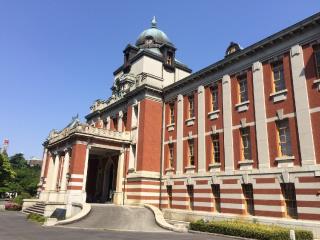
Eastern Area
Nagoya City Archives
This site once housed the Nagoya Court of Appeals, District Court and Ward Court buildings. The Court of Appeals building, the oldest such building still in existence, was built in 1922 and is now a national cultural asset. There is much to see here, including one of Japan's best stained-glass windows, a reproduced courtroom under the old Constitution, a restored conference hall, prisoner lock-up and a commemorative exhibit from the Expo 2005 Aichi. See More
This site once housed the Nagoya Court of Appeals, District Court and Ward Court buildings. The Court of Appeals building, the ol…See More
-

Eastern Area
War and Peace Museum: Peace Aichi
War and Peace Museum: Citizen-Operated This museum was established and is operated by citizens with the aim of learning, preserving, and taking action against wars for the sake of future peace. It was opened in 2007. With approximately 5400 wartime materials donated by citizens, the museum features permanent and special exhibitions, as well as events such as war survivors' narratives, recitals, and lectures. It serves as a museum-level facility dedicated to promoting peace and war education. See More
War and Peace Museum: Citizen-Operated This museum was established and is operated by citizens with the aim of learning, preserv…See More
-
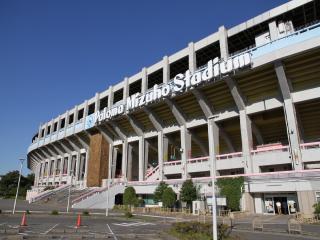
Eastern Area
Paloma Mizuho Sports Park
Paloma Mizuho Sports Park is located within the lush greenery of Mizuho Park, a comprehensive sports park. The park features various sports facilities, including an athletics stadium, rugby field, baseball field, tennis courts, and a training room. These facilities are not only used for sports but also play an important role as venues capable of hosting national and international sports events. The Yamazaki River that flows through the park is known for its beautiful cherry blossoms, making it a popular spot for many citizens to enjoy. See More
Paloma Mizuho Sports Park is located within the lush greenery of Mizuho Park, a comprehensive sports park. The park features vari…See More
-

Eastern Area
Higashiyama Sky Tower
A restaurant with a view on the highest floor Higashiyama Sky Tower stands right next-door to Higashiyama Zoo and Botanical Gardens, and was built in 1988 in celebration of the 100th anniversary of the establishment of Nagoya City. The building is 134 meters tall, but because it stands on an 80-meter tall hill, its observation deck is at a total height of over 200 meters. On clear days, you can see as far as Mt. Ontake, the Suzuka mountains, and the Japanese Alps, and at night there's a romantic night view you can gaze at over dinner that has been selected as a Night View Heritage of Japan and one of Japan's 100 best night views. See More
A restaurant with a view on the highest floor Higashiyama Sky Tower stands right next-door to Higashiyama Zoo and Botanical …See More
-

Eastern Area
The Higashiyama Water Supply Tower.
The Higashiyama Water Supply Tower was constructed in March of 1930 and was used as a water distribution tower to supply water to the Kakuozan area in Chikusa Ward for approximately 43 years until 1973. From 1979, it was repurposed as an emergency water supply facility for disaster response. Additionally, in 1983, an observation deck was added, allowing citizens to enjoy the panoramic view of the city. *Please note that due to ongoing construction work, the tower is currently close. See More
The Higashiyama Water Supply Tower was constructed in March of 1930 and was used as a water distribution tower to supply water to…See More
-

Eastern Area
Water History Museum
The Water History Museum is a place where you can easily learn about the history, role, and disaster prevention aspects of Nagoya's water supply and sewerage projects. It was established to commemorate the 100th anniversary of Nagoya City's water supply and sewerage business. The museum houses over 800 exhibits, showcasing historical materials and items related to Nagoya's water supply and sewerage projects. The friendly museum staff offer guided tours and organize seasonal events for visitors to enjoy. By visiting the museum, you can gain a clear understanding of the development and significance of Nagoya's water infrastructure and its essential role in disaster preparedness. If you're interested in learning about the history of Nagoya's water supply and sewerage, as well as its contribution to disaster prevention, the Water History Museum is the perfect place to explore. See More
The Water History Museum is a place where you can easily learn about the history, role, and disaster prevention aspects of Nagoya…See More
-

Eastern Area
Nittaiji (Kakuozan)
Nittaiji Temple was established in 1904 to enshrine Buddha's ashes and glit bronze received from the king of Thailand in 1900. This is the only non-sectarian Buddhist temple that every sect of Buddhism manages in order. In the temple site, there are a Gandhara style tower, a Hoanto, where the skeletal remains are maintained, a garden called Hassoen, and a tea ceremony room, Soketsuan. The five-story pagoda was built in April 1997. A street fair is held on the 21st day of the month. See More
Nittaiji Temple was established in 1904 to enshrine Buddha's ashes and glit bronze received from the king of Thailand in 1900. Th…See More
-

Eastern Area
Toganji
It is a temple of Soto sect of Buddhism. Oda Nobuyuki, the 3rd son of Oda Nobuhide (the father of the famous warlord, Oda Nobunaga) established this temple to pray for the repose of his father's soul. In its site, gorinto (a gravestone composed of five pieces piled one upon another) is built. Today, Toganji is widely known as the temple of Benzaiten (a Goddess of eloquence, music and art) and show-business personalities visit and pray for a better performance. This temple possesses several temple treasures in the motif of men and women united in conjugal acts including the so-called Sleeping Benzaiten. A 10-meter high statue, the Great Buddha of Nagoya, was erected in 1987. See More
It is a temple of Soto sect of Buddhism. Oda Nobuyuki, the 3rd son of Oda Nobuhide (the father of the famous warlord, Oda Nobunag…See More
-

Eastern Area
Tsuruma Park
The first Nagoya City municipal park, opened in 1909. Tsuruma Park has a Western-style garden with flower beds and a rose garden spread around a fountain on the west side, and a Japanese-style garden with two ponds—Kochogaike Pond and Shobuike Pond—on the east side. The Japanese-style garden has 750 cherry trees, and starting with the cherry blossoms in April, people gather for flower festivals of all kinds—azaleas, roses, irises, and more—following one after another. The park is also home to Okaya Nagoya Hall, a library, and a playground. Come and experience the relaxing aura of this park beloved by all of Nagoya's citizens. See More
The first Nagoya City municipal park, opened in 1909. Tsuruma Park has a Western-style garden with flower beds and a rose garden …See More
-
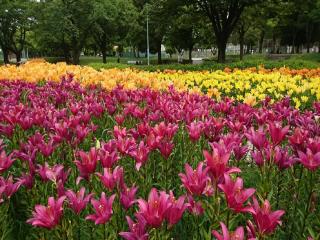
Eastern Area
Chikusa Park
A lush green place to relax and refresh, known as a famous place for lilies Located within a quiet residential area that suddenly opens up into a verdant space, Chikusa Park is also famous for being one of the best places for lilies in Nagoya. Committed to creating a barrier-free place that everybody can use easily, the park is equipped with paths through the park that wheelchairs or strollers can use and multipurpose toilets. See More
A lush green place to relax and refresh, known as a famous place for lilies Located within a quiet residential area that sudde…See More
-

Eastern Area
Yamazaki River
The Yamazaki River, which goes through Mizuho-ward, Nagoya is popular with the inhabitants of the ward. As it is known as the "dankei", the Yamazaki River connotes a valley and there is an area where trees on the steep slope of the bank cover the stream flow. The row of cherry blossom trees is especially widely known and attracts many people. See More
The Yamazaki River, which goes through Mizuho-ward, Nagoya is popular with the inhabitants of the ward. As it is known as the "da…See More













